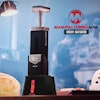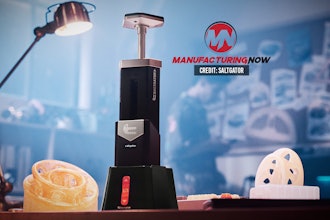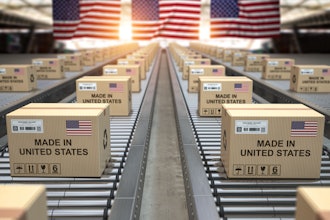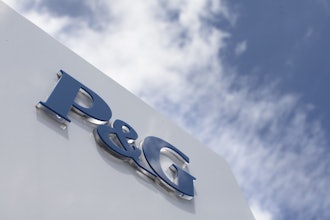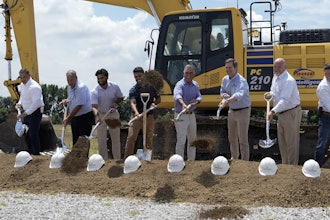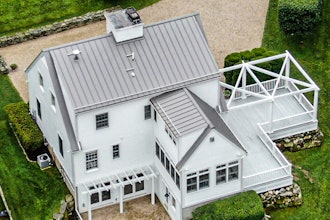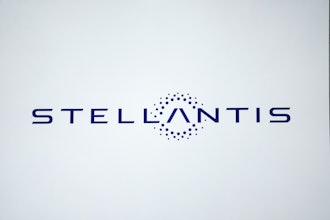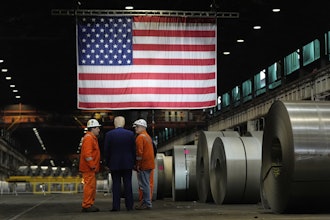With thermal transfer capability up to 50% higher and a processing footprint up to 67% smaller than competing methods, Hydro-Flow technology gives food processors a host of profitable new production options
For every successful food processor, there comes a time when existing production reaches full capacity. Then the difficult decision must be made on whether to pay overtime to push production, increase overhead by purchasing additional floor space and equipment, or to simply turn away new customers if the cost per unit to produce product becomes excessive. Now, however, a breakthrough thermal transfer technology called Hydro-Flow offers food processors substantially more profitable options including maximizing production efficiency by cutting cooker, cooler, and Pasteurizer size by 50% or more to meet production needs with existing floor space; tightening temperature control to within 2°F on all products to boost safety and quality while reducing liability; and in at least one case, a two-year ROI with $50,000 in annual water use and discharge savings with a 27% boost in production.
Hydro-Flow is a new option for rotary drum cooker-coolers that injects and mixes adjustable amounts of air and water with thermally processed foods such as pasta, meat, pouches, and beans for continuous, dynamic thermal processing. The technology delivers heat transfer increases up to 50% higher than traditional heating or cooling methods, such as belt-driven water deluge or stationary vat systems. This allows equivalent production demands to be met in manufacturing floor space up to 67% smaller than competing methods, which offers food processors an array of profitable new production options.
Pasta Producers Retool Production with Hydro-Flow
Recently Bernardi's Italian Foods, a frozen filled pasta manufacturer and subsidiary of Windsor Frozen Foods, found it necessary to add stuffed shell production to a Toluca, Illinois manufacturing line previously producing just ravioli. "We had to maintain existing ravioli throughput and add stuffed shell capacity but couldn't physically fit traditional machinery in the existing space," said Frank Stoeger, the Toluca plant's Facility Manager. "The standard cooker-cooler machinery took twice the space we needed to retool production. We were faced with implementing costly overtime, buying additional production space and equipment, or not supplying the customer with the product needed."
Instead, Bernardi's turned to LYCO Manufacturing, Inc. of Columbus, Wisconsin, for its space saving, patented Hydro-Flow rotary drum technology. While traditional rotary drum cooker-coolers are substantially more space efficient than belt-cooling technologies for example, traditional rotary drum units only use approximately 1/3 of the space available for carrying product. This limits the product load a typical rotary drum unit can handle, and requires greater machine length for satisfactory throughput.
In contrast, Hydro-Flow cooker-coolers use adjustable air and water injection to improve product buoyancy and mixing. This moves product counter to cylinder rotation, offsetting momentum, and can double or triple rotary drum processing capacity. Conversely if output remains constant, the increased capacity means that unit size can be shrunk to one-half or even one-third normal size, depending on the product being processed.
By using Hydro-Flow technology, Bernardi's was able to shrink the 16x8space needed for a standard rotary drum cooker-cooler to just 8x4 for a net savings of 12 of line space and 60 sq. ft. of floor space. Product throughput was increased, however, by increasing the capacity from 37.8 pounds of product per foot of cooker to 76.5 pounds per foot of cooker, or 102% increase.
"Cutting cooker-cooler size by 50% gave us the ability to add stuffed shell processing to our ravioli line without any negative impact," says Stoeger. "Even with a cooker half the length of our previous one, with more product processed in less space, we've had no problem with product clumping or sticking together."
Like Bernardi's, Request Foods - a frozen foods manufacturer with North American distribution - also needed to make maximum use of its factory floor plan for more efficiency. Beyond this, to achieve a savory "al dente" consistency for elbow macaroni mixed with cheese sauce they required faster, lower cooling than the 75°F achieved by a cooling belt. Furthermore, they wanted to substantially reduce the 18,000 gallons per day of make-up water sent to city for treatment, along with the energy used to chill 75°F product down to 0°F in freezers before shipment.
"Logistically, we were limited as to where we could put the machinery due to space considerations," says Pete Sheffield, Maintenance Manager at Request Foods' Holland, Michigan plant. "We wanted tighter controls so after home cooking the pasta would have a nice bite just like it came out of boiling water. And we had to cut water use to cool the product, as we were under tight constraints from the local township to conserve water and send less for treatment."
Again Hydro-Flow fit the bill due to its space, water, and energy efficiency, along with its high thermal transfer rate. The unique combination of water and air injection within a rotary drum keeps water flowing between food products and reduces product to product contact for better, faster thermal processing. When cooking or cooling, product is surrounded by continuously injected hot or cold water with velocity controlled by valves.
Simultaneously, air is injected into internal headers beneath the cylinder to help buoy up food products and distribute them more evenly around the cylinder. Compared to other cooking and cooling technologies, Hydro-Flow has demonstrated heat transfer increases of 25% to 50% or more, depending on the product processed.
Because LYCO cooker-coolers with Hydro-Flow have continuous product flow, an increase in thermal transfer translates directly to a decrease in cooking-cooling time and a decrease in cooker-cooler length. With a smaller machine, more cooking or cooling can be achieved with less water, saving on water use and discharge costs.
The 12 cooling section of Request Foods' new Hydro-Flow unit now lowers product temperature down to 50°F from the previous 75°F, so product goes into the freezer 25°F cooler for a quicker freeze and substantial energy savings.
"We process more with less real estate now since the Hydro-Flow unit let us combine a separate cooker and cooler in a single unit with space savings of about 6 on each section," says Sheffield. "With colder product going into the freezer, we're able to process an additional 4,000 lbs. of product per hour. That's a 27% increase in output."
"Since the unit recycles water, we're also saving about 14,000 gallons of water a day compared to our previous belt cooling method," continues Sheffield. "We save about $300 a day in reduced water use and discharge, or about $50,000 annually. Altogether, we're on track for a two-year ROI."<>
A Practical Post-Pasteurization Solution for Meat Processors
For timesavings and convenience, substantial growth in the fully cooked marketplace continues but federal regulations governing the safety of fully cooked meat products are shifting from command-and-control to performance standards. This shift along the lines of Hazard Analysis Critical Control Point (HACCP) principles means that companies increasingly must establish the safety of their products themselves.
Post-pasteurization of meat products to establish public safety and reduce liability has been one solution and could go a long way toward reducing outbreaks of Listeria, for example, which recently prompted the recall of over 27 million pounds of turkey and chicken sandwich meats.
The post-pasteurization of meat products, however, has fallen short of its potential due to the difficulty in heating product uniformly, and the correspondingly long length of time needed to ensure an entire batch is properly pasteurized. When loading a pile of meat onto a conveyor system, for instance, the meat on top creates a heat barrier so the meat underneath heats slower, requiring more time and cost to ensure the entire batch is safely pasteurized. Pasteurization in standard rotary drum machines, though better, presents a similar problem as cold spots can exist with temperature variance of up to 6°F.
However, LYCO's Hydro-Flow technology now promises to make meat post-pasteurization practical, since its combination of air and water injection can increase throughput up to three-fold per linear foot and reduce temperature variation to just 2°F for all products. Tighter temperature control improves both product consistency and food safety.
Sigma Alimentos, Mexico's leading food processor with US and Central American distribution and a HACCP system in place, is now post-pasteurizing ham products using Hydro-Flow technology.
"Hydro-Flow has streamlined post-pasteurization, especially of low density or high fat products which tend to float," says Victor Moreno, Food Safety Manager for Sigma Alimentos' design group. "Previously low density or high fat products had to receive hot water from a perforated pan on top of a belt, which increases hot water use. Hydro-Flow pasteurizes all sides of meat products simultaneously and evenly, unlike meat in contact with belt pasteurizing systems or other pieces of meat."
Into the Future: Streamlining Thermal Processing for Pouches, Dried Beans, & More
Hydro-Flow technology is also being used to quickly cool hot-pouched products such as soups and tomato paste, so they can be packaged and shipped more rapidly. The technology's continuous, gentle mixing of product also promises to be a boon for the rehydrating of fragile dried beans, since beans on top won't weigh down heavily on beans below, as with other methods. Kidney beans in particular will benefit, as will red, pinto, black, navy, lima, and soybeans.
Pasta, meat, pouch, and vegetable processors are just the leading edge of food processors who will find the space, time, and water savings, as well as thermal transfer efficiencies of Hydro-Flow key in maximizing production and profitability. The trend will only accelerate as federal regulators press ahead with reforms such as required HACCP documentation, intended to make food processors responsible for the safety of their own processes.
For more information about the Hydro-Flow patented technology for cooking, cooling, or pasteurizing, contact LYCO Manufacturing Inc.,115 Commercial Drive, Columbus, WI 53925. (920-623-4152) www.lycomfg.com

